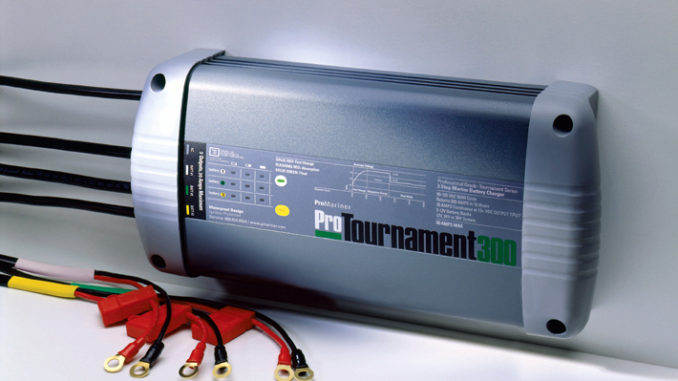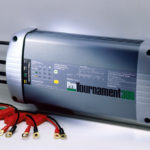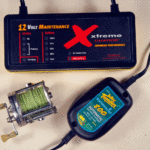
Take steps now to keep it in good shape
Fishing and boating tend to slow down during the winter months, but letting your battery maintenance slow down can be expensive.
Northern fishermen and boaters pulled their boats out of the water months ago, and many have their batteries stored in a cool, dry place where they can be easily monitored. Southern boat owners can use their boats all winter, but most don’t hit the water as often when the weather gets cold and wet. Letting your boat sit unused for a month or two doesn’t hurt anything, as long as you stabilize its fuel and keep its batteries maintained.
If you think that your boat’s batteries aren’t discharging while the boat is sitting on its trailer in your driveway with all its systems turned off, you’re wrong. Batteries self-discharge even when sitting on a shelf, completely disconnected from all loads, and they discharge faster if left in your boat connected to alarms, electronics and engine computers that may draw a small amount of juice even when turned off. You can stop these parasitic loads by disconnecting your batteries or installing battery switches to isolate each battery from its wiring, but you can’t stop the internal self-discharge process.
Kalyan Jana is development support manager for EnerSys, the company that makes Odyssey batteries, including the Trolling Thunder series familiar to fishermen. Jana suggests batteries be fully charged before storage, even if the storage period will only be a few weeks. He says that since each type of battery is charged differently, it is best to consult the battery manufacturer’s charging recommendations first.
The best way to determine the state of charge of a sealed AGM or gel battery is to measure its open circuit voltage with a digital voltmeter at least six to eight hours after charging is completed. Jana pointed out that checking the voltage immediately after charging can give you a false reading and waiting ensures that the chemical reactions inside the battery will have reached equilibrium.
The battery manufacturer’s specifications should indicate the voltmeter reading that corresponds to a full charge. Jana warns that many batteries that are only partly charged when put into storage may experience permanent damage and may not recover their full capacity even if fully charged before their next use. He says that top quality AGM batteries like Odyssey’s Trolling Thunder models have excellent deep discharge recovery capabilities, and are much more forgiving of storage abuses than conventional models. In fact, Trolling Thunder batteries can be stored for two years, or until their voltage drops to 12.0 volts, at a temperature of 77 degrees, and they will still recover.
A battery manufacturer’s specifications may include the lowest temperature recommended for storage. Generally speaking, the lower the temperature, the slower the self-discharge and the longer the safe storage time as long as the temperature doesn’t drop below the maker’s recommended minimum. Southern boaters are not likely to see frozen batteries: A fully charged flooded battery freezes at about 92 degrees below zero and a battery with only 62 percent of a full charge freezes at about 16 below zero.
As goofy as our weather has been lately, I probably should add that you should never try to recharge a frozen battery; always bring it up to room temperature first.
The safest way to store a battery in your boat with all connections in place is to leave it connected to a charger that automatically recharges the battery and then provides just enough current to replace natural internal losses during storage. This can be done by your boat’s onboard charger if it includes (as most do) a float mode or an automatic monitoring circuit that turns the charger on and off as necessary.
If you don’t have a smart onboard charger, a portable Deltran Battery Tender or PulseTech Xtreme unit attached to each battery will do the job. Beware of automotive-type “trickle chargers” that put out constant, unregulated charging current because they can overcharge batteries enough to seriously damage them. Your brain has to provide the computer control for manual chargers: You have to track each battery’s state of charge and apply the number of charging hours it takes for your charger to keep the battery at a healthy level. If you decide to buy an automatic charger, it’s a good idea to check with your battery manufacturer’s customer service department to make sure a prospective charger meets their recommendations.
One of Gale Kimbrough’s jobs has been teaching Interstate Battery dealers how to service and sell the company’s many types of batteries. Kimbrough suggests storing batteries in a well-ventilated, cool and dry place at a temperature between 40 and 68 degrees. The warmer the storage area, the faster batteries self discharge. Kimbrough warns against leaving a charger connected for months at a time unless you know the charger will not over- or under-charge your battery. If an automatic charger is not used, check the state of charge of the batteries at least once a month and recharge them when they fall below 12.5 volts.
Kimbrough says not believing everything you hear about storing batteries can keep you from falling for old urban legends still making the rounds. Storing batteries on concrete, for instance, may have been a bad idea 50-60 years ago when battery cases were made of hard rubber, but today’s polypropylene cases aren’t bothered by it. Battery manufacturers still recommend replenishing battery cells with distilled water but using good, safe drinking water will work in a pinch. The old saw about having to discharge a deep cycle battery all the way down to zero once in a while to keep it operating properly is bunk. In fact, it is better never to discharge one below 50 percent. Lead-acid batteries also never develop a memory — the main reason you store them charged is to prevent plate sulfation (as we discussed here a few months back).
Flooded batteries require a bit more attention in storage than sealed models because you have to keep the electrolyte level in each cell above the battery plates. You can check a flooded battery with a digital voltmeter, but battery experts feel a more accurate way to measure its state of charge is to use a hydrometer. Squeezing a bulb at the top of a hydrometer lets you suck electrolyte from a battery cell up into an indicating area where you can read its specific gravity.
Last, but definitely not least, is the subject of safety. Wearing long rubber gloves and safety glasses or goggles while working around flooded batteries may seem unmanly, but it prevents acid burns on skin, holes in shirtsleeves and potential blindness. You should never smoke around batteries, especially while they are charging or being heavily discharged, because they vent a larger quantity of explosive hydrogen gas at these times, and any spark or flame can ignite it.
Years ago, I was at the lone gas station/grocery store in Rockett, Texas, when a guy pulled in, opened the hood of his truck and started monkeying around with the truck battery’s positive terminal connection. There was a loud bang, and the man staggered back with his hands over his face. Either a loose terminal down inside the battery sparked or his cigarette had ignited the hydrogen gas, blowing the top off the battery. We walked him to the drive’s water hose, and kept running water in his eyes until the ambulance got there and the paramedics took over. He recovered completely, but if he’d been by himself, the outcome might have been different.




